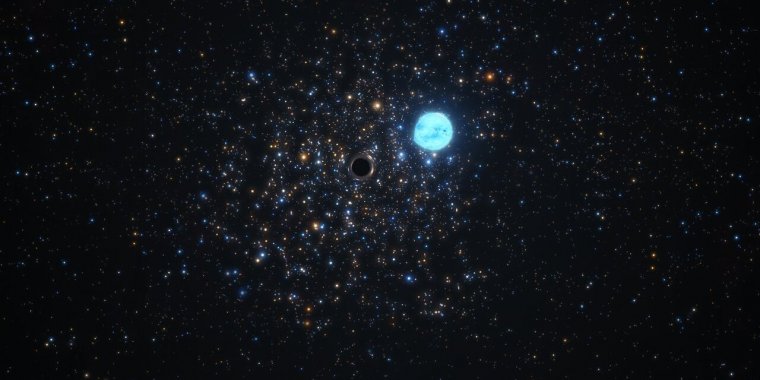| News / Space News |
Black hole found hiding in star cluster outside our galaxy
Using the European Southern Observatory’s Very Large Telescope (ESO’s VLT), astronomers have discovered a small black hole outside the Milky Way by looking at how it influences the motion of a star in its close vicinity. This is the first time this detection method has been used to reveal the presence of a black hole outside of our galaxy. The method could be key to unveiling hidden black holes in the Milky Way and nearby galaxies, and to help shed light on how these mysterious objects form and evolve.

Artist’s impression of the black hole in NGC 1850 distorting its companion star. Photo: ESO
The newly found black hole was spotted lurking in NGC 1850, a cluster of thousands of stars roughly 160 000 light-years away in the Large Magellanic Cloud, a neighbour galaxy of the Milky Way.
“Similar to Sherlock Holmes tracking down a criminal gang from their missteps, we are looking at every single star in this cluster with a magnifying glass in one hand trying to find some evidence for the presence of black holes but without seeing them directly,” says Sara Saracino from the Astrophysics Research Institute of Liverpool John Moores University in the UK, who led the research.
“The result shown here represents just one of the wanted criminals, but when you have found one, you are well on your way to discovering many others, in different clusters.”
This first “criminal” tracked down by the team turned out to be roughly 11 times as massive as our Sun. The smoking gun that put the astronomers on the trail of this black hole was its gravitational influence on the five-solar-mass star orbiting it.
Astronomers have previously spotted such small, “stellar-mass” black holes in other galaxies by picking up the X-ray glow emitted as they swallow matter, or from the gravitational waves generated as black holes collide with one another or with neutron stars.
However, most stellar-mass black holes don’t give away their presence through X-rays or gravitational waves. “The vast majority can only be unveiled dynamically,” says Stefan Dreizler, a team member based at the University of Göttingen in Germany. “When they form a system with a star, they will affect its motion in a subtle but detectable way, so we can find them with sophisticated instruments.”
This dynamical method used by Saracino and her team could allow astronomers to find many more black holes and help unlock their mysteries. “Every single detection we make will be important for our future understanding of stellar clusters and the black holes in them,” says study co-author Mark Gieles from the University of Barcelona, Spain.
The detection in NGC 1850 marks the first time a black hole has been found in a young cluster of stars (the cluster is only around 100 million years old, a blink of an eye on astronomical scales). Using their dynamical method in similar star clusters could unveil even more young black holes and shed new light on how they evolve.
By comparing them with larger, more mature black holes in older clusters, astronomers would be able to understand how these objects grow by feeding on stars or merging with other black holes.
Furthermore, charting the demographics of black holes in star clusters improves our understanding of the origin of gravitational wave sources.
To carry out their search, the team used data collected over two years with the Multi Unit Spectroscopic Explorer (MUSE) mounted at ESO’s VLT, located in the Chilean Atacama Desert.
“MUSE allowed us to observe very crowded areas, like the innermost regions of stellar clusters, analysing the light of every single star in the vicinity. The net result is information about thousands of stars in one shot, at least 10 times more than with any other instrument,” says co-author Sebastian Kamann, a long-time MUSE expert based at Liverpool’s Astrophysics Research Institute.
This allowed the team to spot the odd star out whose peculiar motion signalled the presence of the black hole. Data from the University of Warsaw’s Optical Gravitational Lensing Experiment and from the NASA/ESA Hubble Space Telescope enabled them to measure the mass of the black hole and confirm their findings.
ESO’s Extremely Large Telescope in Chile, set to start operating later this decade, will allow astronomers to find even more hidden black holes.
“The ELT will definitely revolutionise this field,” says Saracino. “It will allow us to observe stars considerably fainter in the same field of view, as well as to look for black holes in globular clusters located at much greater distances.” (European Southern Observatory)
YOU MAY ALSO LIKE





